Raised in a small town where he was viewed as something of an outsider by the locals, Cub Koda had big city dreams; and he worked tirelessly to make them come true. Self-taught on both drums and guitar, he would form his first band and release his first records while still in high school. On stage, Koda combined his impressive guitar chops with a larger than life personality and his ever-beating rock and roll heart. Although he is most famous for being a founding member of Brownsville Station and co-writing the band’s biggest hit, “Smokin’ In The Boy’s Room”, Koda’s career knew no bounds. He was also an accomplished writer and music critic, a dedicated record compiler, a one-of-a kind DJ, a rock and roll and blues historian, and a prankster of the first order.
Cub Koda was born Michael Uszniewicz in Detroit, Michigan on October 1, 1948, the first child of his parents, George and Lois. His sister Andrea was born three years later after the family had moved to Inkster. In 1957, George Uszniewicz, who was of Romanian and Russian descent, officially changed the family’s last name to Koda. The much easier to pronounce and more American-sounding last name was taken from the maiden name of George’s mother, Tessie (Koda) Uszniewicz who had passed away when Cub was just a baby.
According to his younger sister Andrea, the nickname ‘Cub’ or ‘Cubby’ was not what everyone called him as he was growing up; he was ‘Mike’ to his friends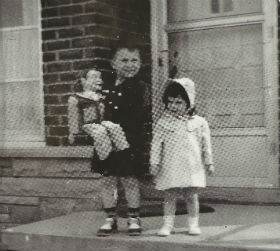 Cub and sister Andrea 1952 and family, but it benchmarked an important moment in his life. “The first time he was referred to as being ‘Cubby’ happened when he performed a drum solo aboard the Detroit cruise ferry, the S.S. Aquarama,” Andrea recalled.
Cub and sister Andrea 1952 and family, but it benchmarked an important moment in his life. “The first time he was referred to as being ‘Cubby’ happened when he performed a drum solo aboard the Detroit cruise ferry, the S.S. Aquarama,” Andrea recalled.
“Our family was sitting in the ship’s lounge area listening to a quartet when Cub started playing along by drumming on the table. The band leader noticed his antics, and invited the ‘little Cubby drummer’ onstage, thereby associating him with the well-known and popular Mickey Mouse Club drummer, Cubby O’Brien. Although my brother had said his name was ‘Mike Koda’, the bandleader capitalized on the moment and called him ‘the little Cubby drummer – Cubby Koda!’. It was Cub’s debut performance and also the moment he realized that making music was no longer a hobby and now his dream.”
“Cub’s initial interest in playing the drums was caused by nerve and tendon damage he suffered from an injury to his right hand and arm at age six,” Andrea revealed. “Our mother, Lois, was 100% Italian and her parents lived in nearby Dearborn, Michigan. Our Italian Nonna (grandmother) had a wringer washing machine that pressed laundry between two rollers before the clothes were hung to dry. Cub was helping Nonna do the laundry when his hand and arm became entangled and trapped between the rollers. The only medical treatment Cub received for his injury was binding bandages to keep his arm and hand wrapped.”
“As his own form of physical therapy, Cub alleviated the pain and numbness by an insatiable desire to ‘bang on things’. This annoyed Mom and Dad but eventually prompted them into buying Cub a set of bongos, drumsticks and a practice pad,” Andrea said. “Cub spent countless hours listening to Buddy Rich, Gene Krupa, Spike Jones, and ‘Mr. Bongo’ (Jack Costanzo) and taught himself how to be a drummer.”
“Cub never had any lessons or training to read or play music,” his sister observed. “He learned how to play instruments like the drums, and later the guitar, mandolin, piano and harmonica, strictly by ear and observation. This unique talent evolved over many years of listening to records and watching performers on T.V. Cub’s methodology was to practice duplicating sounds he heard or movements he saw, internalizing this knowledge, and transferring it to become a skill. This was Cub’s ‘osmosis approach’ to learning.”
In 1957, George Koda moved his family to Clinton, Michigan, and set up his own print shop. During the 1960-61 school year, the Koda’s moved to the tiny village of Manchester, Michigan, following George’s purchase of the Manchester Enterprise newspaper and printing company. Basically a farming community with a population of Andrea and Cub - Halloween 1957 around 1,400, Manchester was founded along the Raisin River in the early 1800’s and was located in the southwest corner of Washtenaw County, about twenty miles from the cities of Ann Arbor to the east and Jackson to the west.
Andrea and Cub - Halloween 1957 around 1,400, Manchester was founded along the Raisin River in the early 1800’s and was located in the southwest corner of Washtenaw County, about twenty miles from the cities of Ann Arbor to the east and Jackson to the west.
Steve Bentschneider was born in Manchester and was in the same grade in school as Cub. He described the village back in the 60's: “Very friendly, you knew everybody. Almost everyone had a job of some kind. It was a tough town because it was filled with World War II vets who were very self-reliant, hard-working, and didn’t take any crap. If there was a problem, it was taken care of by individuals,” Bentschneider recalled. “The adults had made it through the Depression, WW II, and the Korean War. They took care of things themselves – didn’t call the police or resort to lawyers and lawsuits.”
It was an adjustment for Cub to move into a small rural community at the start of his teenage years. In the CD booklet for “The Del-Tinos Meet The Hesitations”, Cub described his first day at school in Manchester: “I walked into my first day in 7th grade at Manchester Junior High dressed to kill; pants pegged to 14 inches at the knee, thin necktie, dress shirt and vest, rat tail comb sticking out of my back pocket and a half jar of grease sculpted into my head. Staring across the room from me was a sea of crew cuts and pink scalps, Future Farmers of America jackets and those kind of dungarees that have a side pocket for holding your screwdriver. I thought I had died and gone to hell. I quickly learned that claiming to have any aspirations toward a career in music and show business was the social equivalent of growing a set of pigtails; it just wasn’t done.”
Cub finally met a kindred soul when Rusty Creech moved to Manchester later in 1960. Rusty was born in Tecumseh, Michigan, but had spent most of his youth in Adrian which had almost ten times the population of Manchester. Creech said of his new home; “I hated Manchester because in Adrian there were pools and theaters and lots of other things that kids liked to do. In Manchester, there was nothing unless you were really into sports.”
Creech called him Mike, not Cub, just like everyone else at school. The two became friends because of their mutual love of music. They avidly discussed Sun records, Fats Domino, Ricky Nelson, and old rockabilly stuff. Rusty’s family was from the South, so he grew up listening to country and rockabilly from the records of his three older sisters. Like Cub, he also watched American Bandstand regularly. Rusty listened to music all the time – he liked just about everything, so he and Cub had a deep connection right from the start.
Since Rusty had a guitar and knew a few chords, and Cub had a snare drum with a ride cymbal, it wasn’t long before the duo started playing together in the front section of the Manchester Enterprise’s office after business hours. Cub described their early efforts when he wrote: “We didn’t sing, we really didn’t know any songs, we didn’t have a name for our little duo/combo (we toyed with the name the Atlantas, then dumped it because it made no sense); we just made rock ‘n’ roll noise and it sounded okay to us.”
After a couple of months, Cub decided to start to play the guitar and sing. All they needed now was a drummer, and they could put together a rock and roll band. They found their percussionist in the person of Doug Hankes, who had recently moved to Manchester from Cincinnati, Ohio, and was a year ahead of both Cub and Rusty in school. Hankes played drums in the marching band but also had a black Premier set of his own.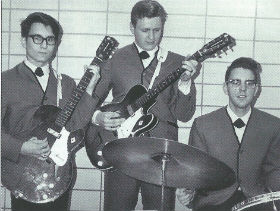 The Del-Tinos (L to R) Cub Koda, Rusty Creech, Doug Han
The Del-Tinos (L to R) Cub Koda, Rusty Creech, Doug Han
Hankes and Cub first played publicly together at a junior high school Band Boosters'concert in early 1963, performing covers of “What’d I Say”, “Roll Over Beethoven”, and “Bo Diddley”. Cub wrote that Rusty was too shy to play; but Creech disputed that version of events in a recent interview saying, “I didn’t play because I didn’t know they were going to do it, but I thought it was pretty cool.”
The Del-Tinos band name was hatched while Rusty and Cub were passing notes in study hall. Cub wrote that they called themselves that “for no other reason than (Del-Tinos) sounded cool and greasy to us.” Rusty, on the other hand, claims that the name was inspired in part from the large Mexican population in Rusty’s former home of Adrian and the fact that it sounded like a rock and roll name.
The band started when they were all in high school. The first gig the Del-Tinos played was in Clinton, Michigan. The venue was called the Teen Canteen and it was located about 6 miles from Manchester. Their trio featured Doug Hankes on drums, Cub on lead, and Rusty playing rhythm with some flat wound strings on his guitar that made a bass sound. They had tried to find a bass player and even had a guy sit in with a sax for a time, but no one worked out.
Rusty Creech stated that Mr. Koda was a big supporter of the Del-Tinos. He let the band rehearse at night downstairs in the newspaper offices. George also bought the instruments for Cub and Rusty. He fronted them the money, and then had the boys gradually pay him back. Mr. Koda helped in that regard as well by providing Rusty and Cub with jobs at the Manchester Enterprise.
Besides publishing the newspaper, George Koda printed handouts for Double A Products, Manchester’s biggest employer, and other businesses. Rusty and Cub would drill holes, wrap the publications, and deliver them to the customers. The Enterprise did all the early printing for the Del-Tinos including business cards, handbills, and took photos of the band. George also bought an older car for the Enterprise's deliveries, and the Del-Tinos ended up using the car to get to their gigs.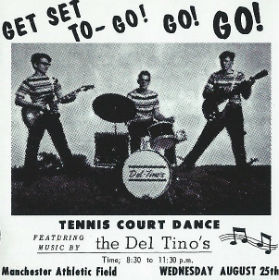 Del-Tinos handbill
Del-Tinos handbill
Rusty and Cub were very close during those years, and the Koda’s looked at Rusty as an almost adopted son. If the Koda’s rented a house by the lake for a couple weeks, Rusty would go along. He would also go camping with Cub and his father.
The Del-Tinos soon started to get gigs in the southeast Michigan strip of teen clubs, drive-ins, high school dances, and dance hall armories that stretched all the way to Toledo, Ohio. Cub wrote about the band during those early years: “Whatever we lacked in mature outlook and schooled musicianship, we made up for in volume, energy, and total commitment to rock ‘n’ roll. We didn’t have the best pompadour haircuts or the coolest guitars or the flashiest stage jackets to wear, but we approached everything like it might be the last time we ever got to play. Every time we played, we wanted to be the best rock ‘n’ roll band there ever was, even if we weren’t. Rock ‘n’ roll is full of dreams and that one was ours.”
When the Del-Tinos weren’t playing, they would often go to Saline or the Sky Drive-In in Adrian to see the Hesitations play. They were a six-man band that the Del-Tinos looked up to. They had matching suits and did steps while performing. The Hesitations were from Adrian, as were Mack Vickery and Wild Bill Emerson - local rockabilly musicians who often played the bars or dances at the American Legion. Since all of the Del-Tinos were under 21, Mr. Koda would often take the boys to see them.
Cub’s sister Andrea remembered that it was almost an oddity that her brother was in a rock and roll band in a small agricultural community like Manchester where it was more about what team you played on. “If a boy had long hair, there was not a general acceptance of him in a small town, a conservative place where everybody plays sports. It’s cool to want to be a rock star now, but not necessarily so back then”.
She said that the Del-Tinos were also going in a different direction: “They weren’t playing the standard hits of the day - the music that you would hear on the radio. I always thought that it was my brother’s idea to combine genres of music – rockabilly and the blues – and come up with a new approach to rock and roll. So forming the Del-Tinos was a very important step in his career”.
That may have been the reason that the Del-Tinos weren’t the first choice for the school sock hops in Manchester or the popular tennis court dances sponsored by the village’s recreation department. “The band didn’t have much of a following," she recalled. "Their main competitors, the Necessities, were from Clinton, the next town over. They were chosen over the Del-Tinos more often than not.”
“He would find ways to make up music constantly”, Andrea remembered of her brother. “We lived in an apartment above my father’s print shop and newspaper. We would often sit there at the window, we didn’t have air conditioning, and look at the cars driving by on Main Street. Cub’s favorite song was the zany hit, “Surfin’ Bird”, by the Trashmen. He would see a car go by and sing something like “There’s a ’56 Chevy with no tires on it”, and go right into a song snippet. He was very sharp and had the ability to see the humor in everyday things.”
Cub was not into sports; so he did not have a membership with the Manchester in-crowd. As a result, he was a bit of an outcast - the complete opposite of sister Andrea who was a cheerleader for all four years of high school. Cub also did not do well in school, again the opposite of his sister. The two were very close, however, since they had no other siblings. Because both of their parents worked at the Manchester Enterprise, they became very dependent on each other.
Andrea did not play an instrument, and her involvement with rock and roll was confined to the dance floor. Cub was very protective of his younger sister and forbade her to date anyone in the band. He was the big brother who wanted to keep her away from what she referred to as “the path of no return”.
The Del-Tinos recorded their first single in 1963. The a-side was a cover of Roy Orbison’s “Go! Go! Go!”; a song that Cub and Rusty had discovered on the flipside of Rusty’s sister’s 78 rpm copy of “Ooby Dooby”, Orbison’s first hit single on Sun Records. The b-side was the instrumental, “Ramrod”, first recorded by Duane Eddy and The Rebels.
The songs were recorded at the United Sound Studios in Detroit and released on the band’s own Del-Tino label; all of which was paid for by Cub’s father. Steve Bentschneider, who lived three blocks from the Kodas, remembered that it was kind of a big deal at school when the 45 came out. It could be purchased at Lannom’s five and dime store and even got a few spins on local radio. At the time, however, it didn't make him a celebrity. Cub was still thought of as simply Mike Coda at Manchester High.
Because he was in a rock and roll band, Cub had hair that was a little longer than anyone else at school. All schools had rules regulating the length of a boy'shair during the early 1960’s, and Bentschneider remembered that Cub asked the Manchester High principal, Chet Koceski, if he could wear it longer than what was allowed by school rules. Cub explained that he needed to wear it long because of the band and performing; and Koceski, showing an open-mindedness rare in school administrators of that time, allowed it. Rusty Creech also recalled Koceski with fondness, and revealed that the principal even gave them the keys to the high school in case they wanted to use the gym to practice.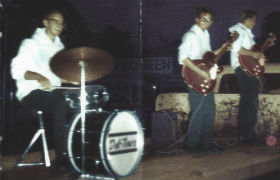 Del-Tinos on Main Street in Manchester: Doug, Cub, and Rusty
Del-Tinos on Main Street in Manchester: Doug, Cub, and Rusty
Arguably, the Del-Tinos' most famous performance in Manchester occurred in the summer of 1964. Cub wrote about it in the Del-Tinos’ CD booklet: “We got on a flatbed truck with a gas powered generator attached to it and rolled down Main Street in the Manchester Fair Parade, the first time a rock ‘n’ roll band had ever been heard by the general town populace, like it or not. Blasting out “Ramrod” as we rolled past the Dairy Queen, Manchester’s main teen hangout, Rusty and I cranked our little Harmony and Epiphone amps to 11 as we met the high school marching band coming the other way. As the old folks held their hands against their ears in protest, the kids couldn’t seem to decide if we were really cool or a bunch of lunatics trying to be a rock and roll band. This flaccid show of support from the hometown crowd lasted throughout our three-year existence, even when we had records out.”
The Del-Tino’s second single, a cover of the Rivingtons' "Pa Pa Ooh Mau Mau", backed with a Koda and Creech composition called “Nightlife”, was released in 1965 and garnered some local radio play. The single was put out on the Sonic label in Detroit. It was owned by Les Cooley, who recorded the band at United Sound and really liked their original song, “Nightlife”. Once again, Mr. Koda paid for the session.
50 years later, HBO used “Nightlife” in Vinyl, their 2016 series on the music business that was created by Mick Jagger, Martin Scorsese and others. A company out of California, in charge of putting together the music for Vinyl, contacted Rusty Creech to get permission to use the song. Rusty didn’t have a clue as to how they were able to locate him. He claims that there were only a few hundred copies of the 45 pressed. They sold it at Lannom’s in Manchester, but Rusty claimed that they ended up throwing copies away.
The Del-Tinos early influences were rockabilly; but after the British Invasion hit, Rusty Creech said they started playing songs by the Beatles and the Stones and other popular groups of the day. They never let go of their past entirely, however. One of their popular live numbers was a remake of the 50’s classic “Stranded In The Jungle” in which, at the point where they would sing “Meanwhile back in the states”, they would go into a current song like “California Sun”.
Like many bands, the Del-Tinos also played a couple of Jimmy Reed songs in their sets. Cub had discovered artists like Reed, Howlin’ Wolf and Muddy Waters from some of the blues-based bands from England, as well as from dialing in John R for Ernie’s Record Mart on WLAC in Nashville late at night. Cub started blowing harmonica at that time and his interest in the blues led to the final Del-Tinos’ 45. It was comprised of a version of Robert Johnson’s “Ramblin’ On My Mind” backed with a cover of the Muddy Water’s classic “I Got My Mojo Working”. The raw recordings were done in a basement in Adrian, Michigan, and released on the Del-Tino label in 1966, the final death rattle of the band.
The Del-Tinos broke up mainly because Doug Hankes, who was a grade ahead of them, went to Michigan State University after graduation and joined the Spartan marching band. He was often traveling on the weekends, and it was hard for the Del-Tinos to get together. They tried it a couple of times when he did get home, but Cub was more into the music than the other two. Doug and Rusty wanted to go out and chase girls while Cub wanted to practice every day. This situation cause conflict and the band ground to a halt shortly before Cub and Rusty graduated high school in June of 1966
In the fall of 1966, Cub enrolled at Northern Michigan University in Marquette. His father had sent him to the college, located in the northern-most part of the Upper Peninsula, thinking that it might provide his son with an opportunity for a more conventional life. Music still ruled, however, and Cub soon connected with three locals (Kim French, and brothers Gordie and Warren McDonald) and formed a garage band called the Blue Blades. According to Cub’s sister, what they had in terms of equipment was shoddy at best – often shorting out and at least once catching on fire.
“Cub came up with a devious and mischievous plan to replace it by claiming to the insurance company that the band’s equipment had been stolen,” Andrea stated. “One of the brothers in the band couldn’t live the lie and confessed. Cub ended up taking the rap for the crime and had to pay restitution to the insurance company. Our father paid the fine and then yanked him out of college and brought him home. He demanded that Cub pay back every cent and even charged him interest.”
Andrea said that paying back the fine was her father’s way of keeping Cub under his thumb. He wanted to support Cub’s musical career, but when Cub got involved in the insurance fraud it was a fall from grace in his father’s eyes. The consequence was that not only was he financially indebted to George but, because his father was badly hurt by his actions, Cub also began a never-ending quest to get back into his good graces.  Cub and Al Nali
Cub and Al Nali
It took Cub several years to pay back the money. He formed a short-lived band with Kim French called the Koda Corporation. When that band broke up, he began a string of part-time and temporary employment including DJ jobs for high school dances and weddings, solo gigs at local bars, and hook-ups with any band looking for a guitar player. Cub worked in a duo with Ronnie Ross in Las Vegas for a short time, and also endured an excruciating stint in an Ann Arbor frat boy band called the Happiness Tickets with matching outfits and hairstyles and a strict playlist. It was one of the things that happened in Cub’s life that made him more determined than ever to play the music he wanted to play.
Cub, who was still known to all as Mike Koda, made a very important career connection when he landed a job in Ann Abor at the Al Nalli Music Store. Nalli would soon become his manager and team him up with Michael Lutz in January of 1969 to form Brownsville Station. Cub wrote about the start of the band in his CD notes for “Smokin’ In The Boy’s Room – The Best of Brownsville Station”: “There were four of us, each the nominal star of rival bands. Tony Driggins was the bass-humping version of Jimi Hendrix fronting a local teen band called The House of Lords. Michael Lutz was the singer-rhythm guitarist of local Ann Arbor faves, The Talismen, who actually had a 45 out. Drummer T.J. Cronley was an absolute wild man, equal parts Keith Moon and Hal Blaine, with a stage persona that would later become the blueprint for Ted Nugent’s Tarzan of rock ‘n’ roll.”
According to his sister Andrea, Cub was permanently saddled with his nickname after he joined Brownsville Station. “Michael Lutz went ‘prima donna’ and objected to having two band members using the name Michael.” Andrea recalled. “My brother didn’t agree with this but he considered Lutz a key player to a successful launch of the group. Lutz was your classic ‘pretty boy’ rocker who had a strong fan base in Ann Arbor.” Lutz was definitely the heartthrob of the band’s female fans, and Andrea said that “Cub would often joke that Lutz was Brownsville’s much-needed groupie bait.” 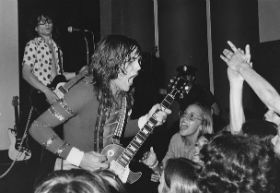 Cub on stage with Michael Lutz
Cub on stage with Michael Lutz
The band’s first single, “Rock & Roll Holiday”, was written by Cub and released on Hideout Records. The small but important label was owned by Dave Leone and is significant for releasing 45s that featured a number of future stars including Bob Seger, Suzi Quatro, and Glenn Frey.
Brownsville released their debut album “No BS” on Palladium Records, a label owned by Punch Andrews, Bob Seger’s manager. the band’s second single, “Do The Bosco” was issued from the album. The title of the song, which was composed by Koda and Lutz, came from T.J Cronley who would challenge band members to compose songs around lunatic suggestions like “Toboggan Au Gratin” or “Bosco Chocolate Syrup”.
Their debut album was then picked up by Warner Bros. Records for national distribution. The company seemed to think that Brownsville Station was a novelty act like Sha Na Na; and when their first Warner Bros. single, "That’s Fine”, failed to chart they were dropped from the label.
The band played gigs all around the country and landed a record deal with Big Tree Records in 1972. Brownsville recorded their second album, “A Night On The Town” for their new label. “Wanted (Dead Or Alive)” was released as a single, but neither the 45 nor the album charted. At that point, the band underwent two major lineup changes as T.J. Cronley left the band to fly planes in the Air Force, and then Tony Driggins departed, which caused Mike Lutz to move over to bass.
With new drummer Henry Weck on board and the band reduced to a trio, Brownsville Station’s first real taste of chart success came when Big Tree’s president, Doug Morris, decided to start producing the band. Morris suggested they do a rock ‘n’ roll version of Jimmy Cliff’s reggae song, “Let Your Yeah Be Yeah”; and it reached # 60 on the Billboard Hot 100 in early 1973.
The success of the single led to the band recording their second Big Tree album titled “Yeah!” with Morris again producing. It contained eight cover songs including their hit single, as well as versions of songs by the Velvet Underground, Terry Knight & The Pack, the Balloon Farm, and a reworking of Robert Parker’s “Barefootin’”. The biggest noise on the album, however, came from the last song, an original written by Lutz and Koda called “Smokin’ In The Boy’s Room”. 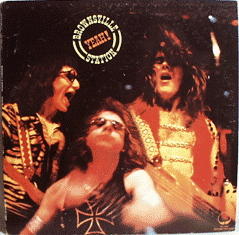 (L to R) Koda Henry Weck and Lutz
(L to R) Koda Henry Weck and Lutz
The song first started to get major FM radio play in Portland, Maine. Doug Morris pressed a couple thousand singles of “Smokin’ In The Boy’s Room” to capitalize on it, and within a week they were all sold out. When the decision was made to release the single nationwide, George Koda did what he could to support his son’s band. He began using the nickname “Max” as an alias to contact radio stations’ call-in lines to request “Smokin’ In The Boy’s Room”. He chose “Max” because he was a big fan of Zero Mostel, and he would identify himself as Max Bialystock to the radio stations. It was the name of the character that Mostel played in the hit comedy, The Producers. From that point on, Cub and his band members continued to refer to him as Max, rather than Mr. Koda, mainly so that his presence at gigs would appear more professionally related.
“Smokin’ In The Boy’s Room” eventually peaked at # 3 on the Hot 100 and helped push the “Yeah” album to # 98 on Billboard’s LP chart, the highest ranking single and album of Brownsville’s career. The single ended up selling 2 ½ million and got the band on every TV rock show that was happening back then, including Don Kirshner’s Rock Concert and The Midnight Special.
The band released the “School Punks” album in 1974. The title was an obvious attempt to build on the success of “Smokin’ In The Boy’s Room”, but the album was only marginally successful, peaking at just # 170. The album did produce two Top 40 singles, however, a cover of Gary Glitter’s “I’m The Leader Of The Gang” and “Kings Of The Party”, an original written by Lutz, Weck, and Koda.
Things started to go south for the band at Big Tree when their next album, “Motor City Connection”, did not chart; and three consecutive singles failed to break into the Hot 100.
After leaving Big Tree, the band signed with the new Private Stock label. In 1977, they released the self-titled “Brownsville Station” album. It was produced by Eddie Kramer who had worked with a who’s who of rock and roll over the years as both a producer and engineer. The list included the Beatles, Rolling Stones, Jimi Hendrix, Led Zeppelin, David Bowie, and the Kinks, to name just a few.
The band had become a quartet again with the addition of Detroit’s Bruce Nazarian on guitar and vocals. Nazarian sang lead on the album’s first single, “Lady (Put The Light On Me)”, which charted at # 46 in the summer of 1977. They had high hopes for the follow-up, “The Martian Boogie”, but when the single stalled at # 56, it seemed to take the life out of the band. Brownsville Station released one more album, 1978’s “Air Special”, before breaking up in 1979.  (L to R) M. Lutz, Bruce Nazarian, C. Koda, H. Weck
(L to R) M. Lutz, Bruce Nazarian, C. Koda, H. Weck
During the latter stages of Brownsville Station, Cub Koda came up with an idea for one of rock and roll’s greatest pranks, a fictitious and hilariously inept bowling alley/lounge band from Detroit called King Uszniewicz and His Uszniewicztones. Cub and his road crew secretly recorded as the horrible-sounding oldies band; and to insure songs like “Surfin’ School” sounded authentically bad, the rule was that no one could play their instrument of choice. Cub reportedly took on the sax-slaughtering solos of bandleader Ernie Uszniewicz.
In order to hook record collectors into the prank, several hundred 45s were surreptitiously pressed and then distributed in Goodwill bins and thrift stores as Brownsville Station toured around the country. As interest slowly grew, Cub planted a story about how Ernie “King” Uszniewicz and his Uszniewicztones formed in Detroit in 1969 as an oldies band, and that Cub discovered them playing in a bowling alley in the Motor City. He was supposedly so impressed with the band’s ineptitude that he took them into the studio and produced a 45 of “Surfin’ School”. The story went on to say that King Uszniewicz and his Uszniewicztones broke up in 1979 after recording a few more singles.
Cub helped keep the hoax going with “The Cub Koda Crazy Show” album issued by Ace Records in 1984. Using the format of a late night rock and roll radio show with Cub as the DJ, the record featured recordings by blues greats like Etta James, Howlin’ Wolf, and Elmore James alongside cuts by Link Wray, Richard Berry, and Frankie Ford, all connected by Cub’s DJ patter.  "Cub Koda Crazy Show" LP
"Cub Koda Crazy Show" LP
The final cut on the album was called the "Cub Koda Crazy Record of the Week"; and Cub introduced it thusly: “Have I got a corker for you tonight! This is one of those great off-the-wall garage band records of all time. I mean, I don’t know how else to put this, but whoever said these guys were a rock and roll band was yankin’ their ankle! Turn up your radios! Turn up your stereos! Get your speakers facin’ up to the wall ‘til it’s crankin’ up to the point of distortion! Here is King Uszniewicz and the Uszniewicztones with the fabulous “Surfin’ School!”
When King Uszniewicz and his Uszniewicztones released their first album, “Teenage Dance Party”, on Norton Records in 1989, the All Music Guide went along with the hoax and gave the record four and one half stars out of five and even printed the band’s fictional history! According to AMG’s band biography by Stephen Thomas Erlewine, “When the album showed up on several college radio playlists in 1989, they earned a minor cult following among both record collectors and young alternative music fans.”
The fact that the prank continued on for another three albums by the group on Norton Records says volumes about Cub Koda’s sense of humor. The type of planning and detail that went into the King Uszniewicz hoax could have only been done by a die-hard music aficionado like Cub, and he must have been thoroughly delighted that it carried on for so long. After being a semi-secret in-joke for two decades, the cat was let out of the bag in a tribute written in 2000 by Texas-born instrumentalist and writer Teisco Del Ray (born Dan Forte) just days after Cub’s death.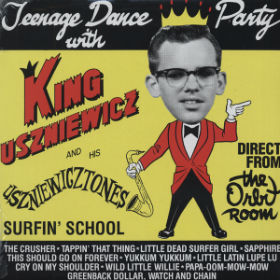
In an interview, Cub’s sister, Andrea, shed more light on the matter. “The photo on the cover of the King Uszniewicz albums is of Cub’s father, but I was not aware of what he was doing to build the prank”, she said. “That is the part of my brother, his sense of humor, that in my heart, I miss the most. It went beyond being the quick-witted, sarcastic, and mischievous rogue.”
Andrea also revealed the person who might have been the original inspiration for the prank. “Our Usniewicz-Koda grandparents migrated from Romania to Poland and then onto the United States. Our ‘Papa’, Andrew Uszniewicz, never spoke a word of English, but he would often entertain the family by playing his violin and wearing his beaded hat that looked like a crown; hence King Uszniewicz!”
Cub married the love of his life while he was playing in Brownsville Station. According to an interview that Jeannie Koda did with William Hanson for a Deadline Detroit story titled An Ode to Cub Koda of Brownsville Station, she first saw Cub in 1966 when the Del-Tinos played a dance at Chelsea High School during her sophomore year. “It would be eight years before she came across Koda again. At an Ann Arbor party thrown by a mutual friend, they noticed each other. She worked as a seamstress at Homemade Things, a little shop near Jacobson’s department store in Ann Arbor, and was going through a divorce.” He flirted with her and she had no idea of his celebrity. ‘At some point he got down on his hands and knees and asked me to marry him. I walked away.' Later she asked the host, ‘Who was that ass?’ Koda pursued her and asked her to make shirts for him. She refused, but eventually agreed to make a jacket for him.” **
“They were married a year and a half later. He called her Lady J. She called him Michael. They lived on Valley Drive on Ann Arbor’s west side until the summer of 1978, when they headed back to the country, near Chelsea. They built a modest home with a 16 by 20 ft. office/studio for Cub and a place to store his phenomenal record collection, newspaper articles, photos, tapes, guitars, and amps.” ** 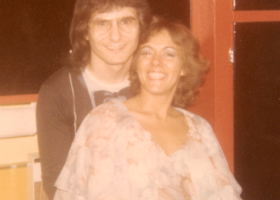 Cub and Jeanne (Lady J) on their wedding day
Cub and Jeanne (Lady J) on their wedding day
“Early in the marriage Cub found out he was diabetic and that he had to regularly inject insulin. ‘He had to watch his sleep and diet and so on,’ Jeannie told Hanson. ‘He did the best he could but he was a meat-oriented, cigarette-smoking rock and roller. He drank quite a bit – mostly Jack Daniels – when I first met him. The Brownsville guys were rowdy and loud.’” **
Cub’s sister, Andrea, wrote this about his health issues: “In the 70’s Cub was diagnosed with Juvenile Diabetes/Type 1, a serious and life-altering disease that can be difficult to manage, especially someone with a rock and roll lifestyle. Few people knew or understood how Cub was impacted by complications from his disease. This was a very private side of Cub that he struggled to accept and wanted to keep from others.”
After Brownsville Station broke up in 1979, Cub started his solo career. Before the band came to an end, he purchased a multitrack recorder and started producing one-man tapes of the music he loved: rockabilly, blues, R&B, country, early rock and roll, and jazz. These recordings would later be issued on the album “That’s What I Love About The South” in 1984.
From late 1979 to late 1980, Cub started playing with three members of a Detroit-based band called Mugsy. Renamed Cub Koda and the Points, their eponymously titled first album was released in early 1980 by Boston-based Baron Records on hot pink vinyl. They also released an EP titled “Shake Yo Cakes”. Two singles were issued from the album: “Sneakers On A Rooster” b/w “Ducktail” and “Jail Bait” b/w “Welcome To My Job”. Unfortunately, the band broke up because of financial difficulties before releasing a second album. 
Following the break-up of the Points, Cub started playing with the Houserockers, the late Hound Dog Taylor’s backing band. The trio featured Cub on guitar and vocals, second guitarist Brewer Phillips, and drummer Ted Harvey. The group would play regularly for the next fifteen years. Cub Koda & the Houserockers released the “It’s The Blues!” album on Baron in 1982. Their second album, “The Joint Was Rockin’”, was issued in 1996.
In 1983, Cub released another solo album, “Let’s Get Funky”, on the New Rose label. The title song b/w “Ten Little Women” was released as a single the following year.
After the 1984 release of both the aforementioned albums, “The Cub Koda Crazy Show” and "That's What I Like About The South", there were no new recordings for the next five years. Although he continued to tour, Cub began writing in earnest for numerous music magazines, notably his column The Vinyl Junkie for Goldmine magazine and later for DISCoveries. Cub also wrote three volumes of the acclaimed Blues Masters series, and wrote reviews and contributed to books published by Allmusic, formerly the All Music Guide. Cub had the rare talent of bringing the same love and excitement for rock and roll to the written page that he communicated to his audiences every night he was on stage.
“He knew more about music than he did anything”, Cub’s wife Jeannie told William Hanson. “That’s why I drove when we went on trips. He was too distracted thinking about music. He couldn’t tie his shoes or balance a checkbook to save his ass – all the regular things people do. But give him a guitar, an amp, and an audience, and he would blow you away.” **
After he and Cub graduated from Manchester High in 1966, Steve Bentschneider said they saw each other only infrequently. Bentschneider went on to trade school and became a tool and die maker. After he got married, Steve lived in Manchester for a number of years and said that Cub attended both the 5th and 10th high school class reunions. He remembered that it was a big deal in Manchester when “Smokin’ In The Boy’s Room” became a hit, but he never saw Cub perform in concert with Brownsville Station.
Rusty Creech, Cub’s old bandmate in the Del-Tinos, said they also did not see much of each other after the band broke up and they graduated. Creech had enlisted in the Air Force by the time Brownsville Station came together. “I heard about him and some of his other bands over the years but I didn’t go and see him play until I attended an oldies show at the Monroe Fair where he appeared along with Mitch Ryder”, Rusty recalled. Creech also stated that he felt that Cub never found his true love as far as music, whether it was rock, blues, or country. “It seemed that he was always searching for a sound but never quite found it.”
Cub’s sister liked the way that her brother tried to never be locked into one sound. “He always wanted to reinvent himself through using other artists to influence what he was going to create. I find that inspirational,” Andrea said. “He didn’t want to be a ‘Johnny One Note’ or a ‘One Trick Pony’. He wanted to see it as an array of opportunities to pull sounds together and communicate with everyone.”
Andrea attended Michigan State University and went into education. She started as a classroom teacher then went on to become a reading specialist. Andrea thinks Cub was an educator as well, in that he wanted to increase everyone’s love of music. “We always kept in touch and I would receive things he wrote in the mail or by email,” she recalled. Andrea said she still has the things he gave to her, including parts of his record collection. “He loved to turn people on to undiscovered gems.” 
Cub returned to the recording studio in 1989 for his “Cub Digs Chuck” album on Garageland Records, a tribute to Chuck Berry, one of his musical heroes. Although several of his earlier albums were released on CD in 1990, his first official CD release was his Bo Diddley tribute album, “Cub Digs Bo”, also issued on Garageland.
He continued his busy schedule of touring, recording, and writing throughout the 90’s. 1993 saw the release of “Smokin’ In The Boy’s Room: The Best of Brownsville Station” on Rhino Records. It was a timely reminder to younger rock fans of where Motley Crue got the hit song that first put them on the map. That same year, “Welcome To My Job”, a CD retrospective of his non-Brownsville recordings, was released on Blue Wave Records.
Wherever Cub performed his audiences always expected him to play “Smokin’ In The Boy’s Room”. In an interview with the Detroit News, he was asked whether he minded always being identified with his big hit, and whether he viewed it as a “gold-plated curse”. “Are you nuts?” he replied. “For a short white kid with big glasses from the Midwestern sticks to be in a band that makes a record that gets played on the radio that a million people go out and buy – how can that possibly be a curse? I can think of a whole lot of people, with maybe even more talent, to whom that has never happened. That’s no curse, mister. That’s a blessing.”
In 1994, Cub released an album on Schoolkids Records called “Abba Dabba Dabba: A Bananza of Hits”. The label was run out of the legendary Schoolkids Record Shop, then located at 523 E. Liberty in Ann Arbor. One of the album highlights was a field holler called “Random Drug Testing” with its unforgettable lyric, “Well the boss man says you gotta pee in the cup, pee in the cup, pee in the cup…” Cub took the stage in Ann Arbor for the first time in ten years to promote his latest release. 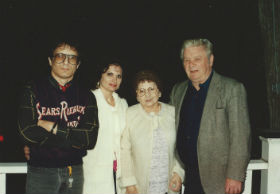 Cub, Andrea, Lois and Max Koda 1990s
Cub, Andrea, Lois and Max Koda 1990s
Cub recorded the acoustic solo album, “Box Lunch” in 1997 on J-Bird Records. The following year, the recordings he made with the Del-Tinos along with those made by the Hesitations, the local band that inspired Cub’s first band, were released on the Norton Records CD, “The Del-Tinos Meet The Hesitations – Go! Go! Go! To Surfin’ School”.
In 1999, he reformed Cub Koda & The Points. The band recorded a new album called “Noise Monkeys” in 2000. In an interview with the Detroit News, Cub expressed his excitement with his newest project: “This last year has been the most hectic and maybe the most creative in my whole life,” he said. He also called his latest album a landscape of American music: “Beneath that topcoat of fluff fun, what I was really trying to show was the interconnectedness of all these forms of American music,” he said. “You’ve got 60’s garage noise to Tex-Mex instrumentals to Detroit doo-wop to Chicago blues to Southern rockabilly. I could’ve stuck country or jazz tunes on there, and it wouldn’t have made any difference. It’s all rock ‘n’ roll.” Sadly, it would be his final recording.
On June 30, 2000, while promoting his new album, he became ill. “Cub always said he wouldn’t make old bones,” Jeannie recalled in her interview with Hanson. “Too many years on the road, and living hard. I don’t think he knew he was going to die, but he knew he was sick,” she said. “During the last few weeks of his life he was getting dialysis three times a week.” On the night he passed, he was recovering from a medical procedure from earlier in the day. **
Jeannie described Cub’s final moments to Hanson: “He called his dad, I fed him. He lay down on the couch and went to sleep.” At 1:00 a.m. he woke up and was in distress. Jeannie and the EMS techs performed CPR and he was rushed to Chelsea Community Hospital. A couple of hours later, in the early morning of July 1, 2000, Cub Koda, one of the most unique and colorful musicians of his era, was gone. **  Cub and Lady J
Cub and Lady J
Cub and Jeannie did not have children together but he is survived by a stepson, Jesse Easuades, from Jeannie’s first marriage. Jesse moved to California to live with his father shortly after Cub and Jeannie wed but would visit during the summer and on holidays. Cub and Jesse forged a strong relationship, especially after Jesse graduated from high school and attended Carnegie Mellon University in Pittsburgh where he currently resides. Jeannie (Lady J) lives in Michigan and administers the Official Cub Koda website.
Jeannie told Hanson that she and Cub had talked long before, and had agreed on the two records that would be played at his funeral. She chose the gospel song “Don’t Knock,” by the Staple Singers. Cub had something more unconventional in mind, which resonated with his musician friends: “Surfin’ Bird,” by the Trashmen. **
Stephen Thomas Erlewine wrote this about Cub in Billboard magazine shortly after his death. “Cub kept working and rocking until the end – he was writing and recording music in the last week of his life. He never lost his love for music and he always shared that love anyway he could, whether it was as a musician, journalist, DJ, or friend. As he said, he was 'somewhere between a cult figure and rock & roll legend,' and to anyone who knew him, that was the gospel truth.” Cub Koda's gravestone at Mt. Hope Cemetery
Cub Koda's gravestone at Mt. Hope Cemetery
Cub's monument is located in the Mt. Hope Cemetery in Waterloo. Michigan, located near the Jackson County - Washtenaw County line.
In honor of his many contributions to the rich legacy of music in Michigan, Cub Koda was voted into the Michigan Rock and Roll Legends Internet Hall of Fame in 2016 for both his solo and group work outside of Brownsville Station. Cub had previously been inducted into the MRRL Hall of Fame with Brownsville Station in 2008. “Smokin’ In The Boy’s Room” was voted a Legendary Michigan Song in 2009.
Main Sources:
**An Ode to Cub Koda of Brownsville Station by William Hanson
"Mr. Smokin' In The Boy's Room, Cub Koda" The Official Site.
Interviews with Andrea Koda Boulanger, Steve Bentschneider, Rusty Creech, and Paul Heinrich.
Video: Watch Cub blast through "Johnny B. Goode" and "Barefootin'" at the Wadena Rock Fest in 1995. https://www.youtube.com/watch?v=u-JOOiRipUg

